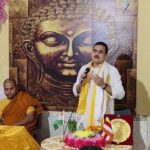Can Congress hear Assam’s wake up call now?
- By : Anirban Ganguly
- Category : Articles
Just about four years ago, between August and October 2008, around 70 people were killed in clashes between the Bodos and the Muslims in the northern Assam districts of Udalhuri and Darrang.
The clashes had seen 100,000 people rendered homeless on either side.
The Tarun Gogoi-led Congress government in Assam, exulting in its hat-trick has, it appears, learnt no lessons from that past situation of riot nor taken any concrete measures in the last four years to sort out ethnic and land issues in the region.
Even the present chain of violence, a repetition of past cycles, elicited a delayed response and then a denial of gravity and seriousness.
In fact, having ruled Assam for the longest period, post independence, the Congress can hardly escape blame for the present state of things in the state. A lot of it is the result of its political schemes and strategies implemented in the state during the past five odd decades.
The issue at hand is to briefly see a few angles to the conflagration and, while hoping that peace and sanity soon return to the area, call for the immediate deliberation on certain fundamental issues that need to be addressed.
Land has been at the centre of conflicts in this region, which comprises the Bodo Territorial Area District.
Land-related clashes have occurred at regular intervals since 1993.
The period between 1993 and 1998 was especially bad in terms of killing and displacements.
In October 1993, around 50 people were killed in clashes between the Bodos and immigrant Muslims in Bongaigaon district. July 1994 saw clashes erupt again between the Bodos and Muslims, leaving an estimated 100 dead, while the May 1996 clashes between the Bodos and Santhals left 200 dead. Clashes between the communities repeated again between May and September 1998.
The problem seems to have multiple dimensions to it.
One view is that the Bodos, due to historical reasons of being displaced from their lands, have always fiercely protected their turf and have actively resisted any encroachment.
The policy of settling migrant Bengali Muslims from East Bengal was part of the colonial scheme of things. The British decided to settle Muslim peasants in order to increase food production and were thus ‘responsible for the land alienation of the Bodos.’
The Wasteland Settlement Policy of the British was a liberal one and allowed the cultivators to grab large swathes of land. The tribal’s jhoom cultivation land was encroached in the process.
The adivasis brought by the British from other parts of India, were the other settlers who fulfilled the labour requirement in the tea plantation sector. This situation developed for over a century creating pressures on tribal lands that evolved into conflicts.
Migration continued unabated even when East Bengal became East Pakistan. Pakistan saw it as its legitimate right to claim Assam’s space and resources.
Earlier, the Muslim League government of Mohammed Sadullah, which took over in wake of the resignation of the Gopinath Bordoloi led coalition, discontinued the line system set up by the British and released huge land and grazing reserves for the occupation of the East Bengali settlers.
In tune with that policy, Zulfikar Ali Bhutto, also referred to Assam in his book Myth of Independence.
He referred to Assam and some districts of India adjacent to East Pakistan to which Pakistan has a very good claim, ‘and which should not have been allowed to remain quiescent.’
Thus, post-partition and post-formation of Bangladesh, the inflow continued generating tensions and clashes and has been almost always at the root of the present as well as past conflicts.
The other issue, which has been highlighted, is the inbuilt contradictions in the BTC, formed under the Sixth Schedule of the Constitution.
A number of minority Bodo-areas comprising Adivasis, Rajbonghshis and others have also been included in the BTAD in order to make the body contiguous. This has caused resentment and fear in the past and continues to unsettle the situation.
There have been calls to have a relook at the composition and structure of the BTAD and the BTC itself in order to avert future clashes. An urgent revisiting of these structures is what is required when passion calm down. The process may be a protracted and long-winding one but there is no alternative.
Adding another dimension to the entire episode, local reports have also observed that easy availability of firearms in Kokrajhar combined with extortion rackets run by the National Democratic Front of Bodoland and sections of the ruling coalition in the area have often led to clashes and lawlessness and escalation of conflict situations.
The present conflict, these reports have argued, is the result of an abject failure of governance at the state level and the Centre’s unwillingness to take steps to solve the various problems plaguing the region and its administrative framework.
The immigration angle, however, cannot be discounted altogether.
Gossaigaon subdivision, which is one of the worst affected, has a large immigrant population.
In his much-discussed 1998 report to the President of India, the then Assam Governor Lt Gen (retd) S K Sinha had pointed to the growing presence of immigrants from Bangladesh and the gradual demographic, ethnic and cultural challenges it would pose to the indigenous communities in Assam. The report had also argued to look at the issue from the national security point of view.
The immigration issue remains at the core of much of the conflict that Assam has seen in the past three decades.
The present situation has also reminds one of the plight of the Jummas — ethnic minority groups in the Chittagong Hill Tracts districts of Bangladesh.
Ever since Pakistan was formed it became the policy of the East Pakistan government in 1950s and 1960s to settle Bengali-Muslim peasants from the plains in the hills of Chittagong and generate pressure on tribal land.
This policy was aimed at altering the demographic pattern in the region and gradually drove large sections of the tribal population into becoming refugees — 40,000 Chakmas sought refuge in India. The engineered ethnic tensions engendered riots, which continue to this day.
February 2010 saw some of the worst land-related riots between indigenous Chakmas and government-settled Bengali Muslim populations in the CHT.
In 1960, the East Pakistan government’s Kaptai Hydroelectric project on the Karnafuli River flooded 1.036 sq km of tribal land and is said to have submerged 54 per cent of the best arable tribal land.
Independent Bangladesh, especially under Zia-ur-Rehman in the late 1970 and early 1980s, continued with the policy of tribal land alienation and political marginalisation of the Jumma people leading to major ethnic unrests in the area.
The current unrest in Assam has also similarities.
Continuing immigration from Bangladesh into tribal lands in Assam keeps increasing tension and generating cyclical clashes. Local factors and ethnic equations serve to further compound the issue.
On the flip side, the Indian government is not even willing to take up the issue of immigration and the effects of a consequent demographic change with the Bangladesh government.
The issue of infiltration figured nowhere on the agenda during Bangladesh Prime Minister Sheikh Hasina’s visit to India in early 2010 and Manmohan Singh’s visit to Dhaka in 2011 and one is not certain how far the Coordinated Border Management Plan will go in abating the situation.
The problem has assumed gigantic proportions, but ignoring it, is obviously going to serve no purpose.
It will only exacerbate the situation on the Indian side of the border.
Leaving rhetoric aside the two sides must be at least willing to talk the issue out and place it among the major agenda points in future discussions and joint-communiques.
The Bangladesh media and a section of the Indian media continue to highlight every BSF firing that takes place along the border. In a similar vein there ought to equally develop a balanced and considered debate on the issue of illegal immigration into India from Bangladesh.
The socio-cultural effects of a gradual demographic change due to such immigration need to be equally discussed and highlighted. Throwing a shroud of silence over these issues will serve no purpose except to postpone the inevitable.
Instead of rejoicing at its political hat-trick of ruling Assam for three consecutive terms, the Congress could well stop politicking over the current situation — law and order in Assam has indeed badly deteriorated at all levels — accept its failure and get its acts together and display that there is indeed a Union government.
But then, is it capable of really providing leadership any longer?

















